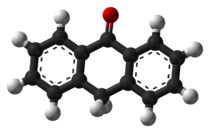Anthrone
 | |
 | |
| Names | |
|---|---|
| IUPAC name
10H-Anthracen-9-one | |
| Other names
Carbothrone; anthranone; 9-oxoanthracene | |
| Identifiers | |
| 90-44-8 | |
| ChEBI | CHEBI:33835 |
| ChEMBL | ChEMBL124440 |
| ChemSpider | 6751 |
| |
| Jmol-3D images | Image |
| PubChem | 7018 |
| |
| Properties | |
| Molecular formula |
C14H10O |
| Molar mass | 194.23 g·mol−1 |
| Appearance | White to light yellow needles |
| Density | Solid |
| Melting point | 155 to 158 °C (311 to 316 °F; 428 to 431 K) |
| Boiling point | 721 °C (1,330 °F; 994 K) |
| Insoluble | |
| Except where noted otherwise, data is given for materials in their standard state (at 25 °C (77 °F), 100 kPa) | |
| | |
| Infobox references | |
Anthrone is a tricyclic aromatic ketone. It is used for a popular cellulose assay and in the colorometric determination of carbohydrates.[1] The anthrones are used in pharmacy as laxative. They stimulate the motion of the colon and are responsible for less water reabsorption. They may only be used for a short amount of time, because long time use may lead to loss of elecktrolites. Anthrones are gained from rhamus frangula, rhamnus purshiana, aloe feroxx, rheum officinale,cassia senna, cassia anugustifolia,..
References
- ↑ Trevelyan, W. E.; Forrest, RS; Harrison, JS (1952). "Determination of Yeast Carbohydrates with the Anthrone Reagent". Nature 170 (4328): 626–627. doi:10.1038/170626a0. PMID 13002392.